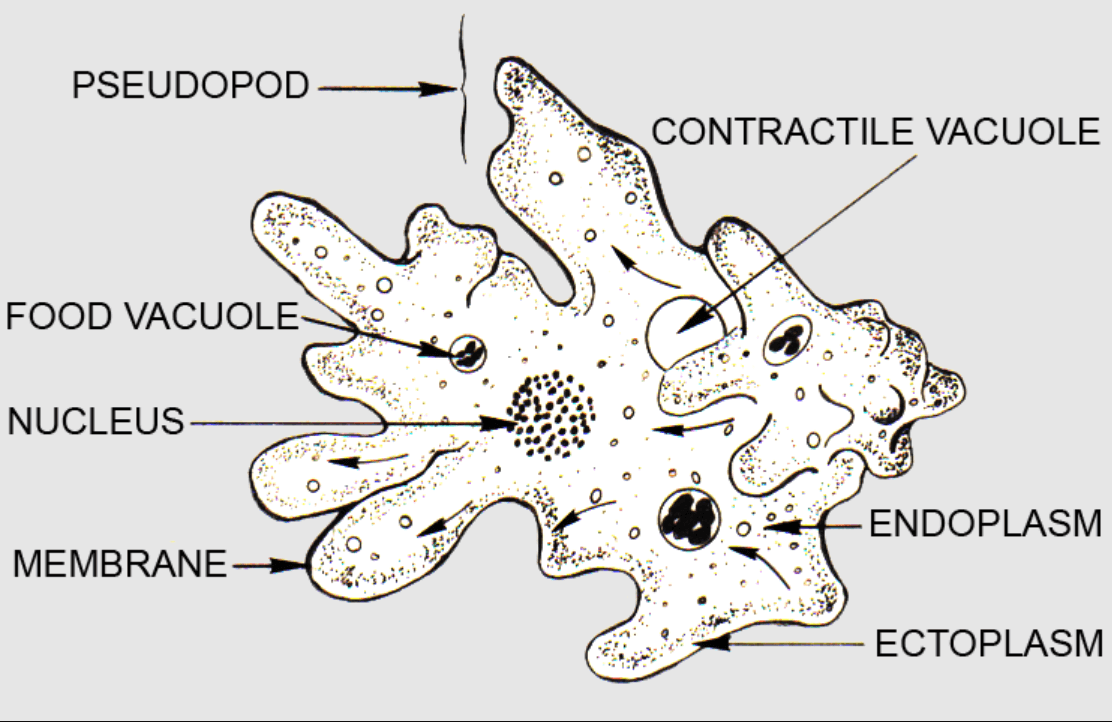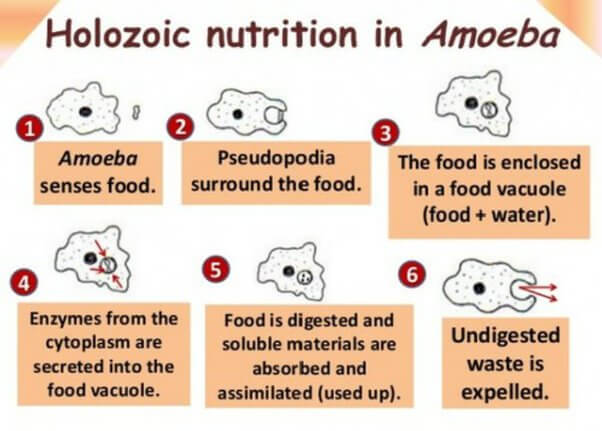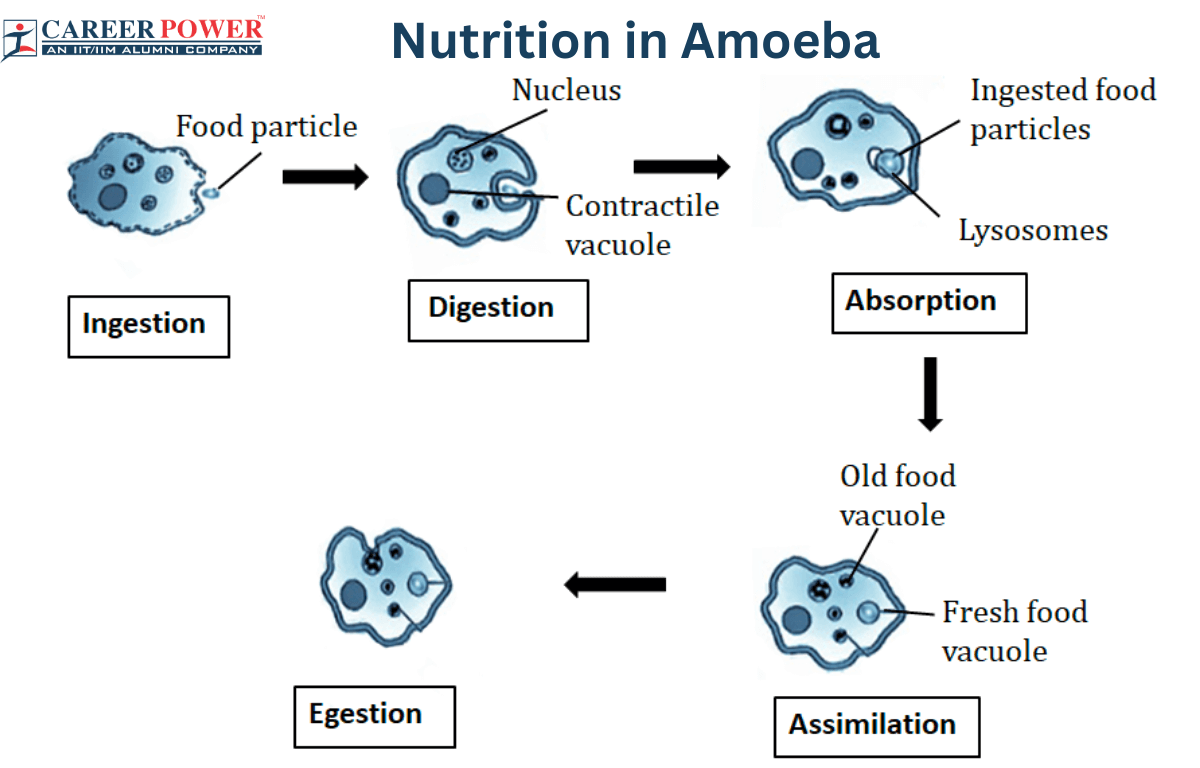As we all know nutrition is the process by which our bodies obtain and use nutrients from our food. These nutrients include carbohydrates, proteins, fats, vitamins, and minerals, and they play a crucial role in maintaining our overall health and well-being. A balanced diet that includes a variety of foods helps ensure that we get the necessary nutrients to support our bodily functions. Different organisms have varying nutritional needs based on their characteristics, lifestyles, and environment. Here we have discussed the nutrition of Amoeba.
Nutrition in Amoeba
Amoebas are single-celled organisms, and their nutrition primarily involves engulfing and absorbing food particles through a process called Phagocytosis (“Phagocytosis” means “cell feeding”). They feed on small organisms like bacteria and algae. Once engulfed, the amoeba forms a food vacuole around the food particle, and enzymes are released to digest it. The nutrients released from the digested food are then absorbed into the cell for energy and growth. We can say that the amoeba uses the Holozoic mode of nutrition.

Holozoic Nutrition
In Holozoic nutrition, the amoeba extends pseudopodia to capture prey, or we can say that the amoeba engulfs food particles through phagocytosis. The prey is enclosed in a food vacuole. Enzymes break down the prey into nutrients, which are absorbed across the vacuole’s membrane. This process sustains the amoeba’s energy and biological functions.
Process of Nutrition in Amoeba
As we already discussed that the process of nutrition in amoeba is known as Phagocytosis. As we know Amoeba and paramecium are two simple organisms. Their bodies consist of a single cell, so they are also called unicellular organisms. In unicellular organisms, all the bodily processes including stages of nutrition are performed in a single cell. The steps or stages of nutrition in amoeba involve Ingestion, Formation of food vacuole, Digestion, Absorption, Assimilation, and Egestion.
| Steps of Nutrition in Amoeba | |
| Steps | Overview |
| Ingestion | Pseudopodia extend, enveloping food, forming a food vacuole for digestion and absorption. |
| Formation of food vacuole | Pseudopodia enclose captured food, creating a membrane-bound sac for digestion. |
| Digestion | Enzymes break down food in the vacuole into simpler molecules for absorption and energy. |
| Absorption | Nutrient molecules from digested food move into the amoeba’s cytoplasm for utilization. |
| Assimilation | Amoeba utilizes absorbed nutrients for energy production, growth, and maintenance of cellular functions. |
| Egestion | Removal of undigested waste materials from the amoeba’s body after digestion is complete. |

Ingestion
Ingestion in amoeba is the process by which the organism takes in food particles. Amoebas use a process called phagocytosis, where they extend their cell membrane to surround and engulf food particles like bacteria or small organic matter. Once inside the cell, the engulfed particle is enclosed in a membrane-bound sac called a food vacuole. The amoeba then releases enzymes into the food vacuole to break down the ingested material, allowing it to be digested and absorbed for nutrients.
Formation of Food Vacuole
The formation of food vacuole in amoeba occurs during the process of phagocytosis. When an amoeba wants to eat, it wraps its cell membrane around the food and creates a tiny bubble called a food vacuole. This bubble holds the food inside. The amoeba then releases special juices that break down the food into tiny pieces. These pieces are absorbed into the amoeba’s body to give it energy. After the amoeba takes what it needs, it pushes out the parts of the food it can’t use.
Digestion
Digestion in amoeba is like breaking down food to get energy. Once the food is inside the amoeba’s food vacuole, special chemicals are released. These chemicals help break the food into smaller pieces. The amoeba absorbs these small pieces into its body to use them for energy and growth. Anything left over that the amoeba can’t use is used out of the cell.
Absorption
Absorption in amoeba is when the small pieces of digested food, which are now nutrients, move from the food vacuole into the amoeba’s body. The cell membrane of the amoeba lets these nutrients pass through and enter the cytoplasm, where they are used for energy and other essential processes. This helps the amoeba grow and stay alive.
Assimilation
Assimilation refers to the process by which these single-celled organisms engulf and absorb food particles, typically through phagocytosis. During assimilation, the absorbed food nutrients are used by the amoeba’s metabolic processes. Amino acids are used for protein synthesis, glucose is used for energy production through cellular respiration and fatty acids are used for various cellular functions.
Egestion
Egestion in amoeba involves the expulsion of waste materials or undigested remnants after the digestion process. As the amoeba engulfs and digests food particles within its food vacuole, indigestible components, and waste materials accumulate. After the assimilation of the nutrients from the digested food, the amoeba eliminates the waste by fusing the food vacuole with its cell membrane through exocytosis. This process ensures the removal of non-essential materials and helps maintain the amoeba’s cellular health and functioning.
Importance of Nutrition in an Amoeba
Nutrition is the foundation for an amoeba’s vitality, growth, reproduction, and adaptability, allowing it to thrive within its environment.
- Energy Production: Nutrition provides the energy needed for amoebas to carry out essential cellular processes, including growth, movement, and reproduction.
- Reproduction: Adequate nutrition ensures that amoebas have the resources necessary for successful reproduction through processes like binary fission.
- Homeostasis: Nutrient intake helps maintain the osmotic balance within the cell, ensuring a stable internal environment.
- Defense Mechanisms: Nutrients contribute to the production of molecules that aid in defense against pathogens and harmful substances.
- Longevity: Well-nourished amoebas are more likely to have the ability to repair and maintain cellular structures.



 50 Vegetables Name for Kids in English a...
50 Vegetables Name for Kids in English a...
 Food Chain: Definition, Types, Examples,...
Food Chain: Definition, Types, Examples,...
 Human Respiratory System: Definition, Di...
Human Respiratory System: Definition, Di...













